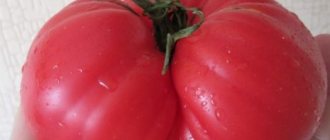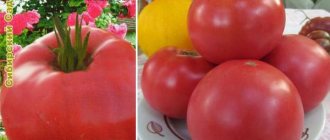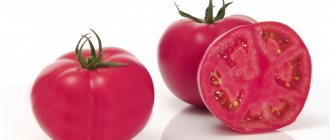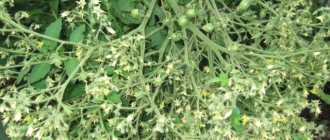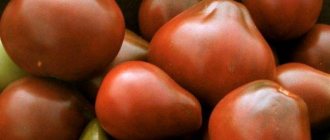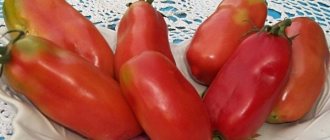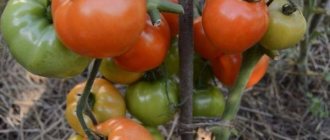What's unusual about the Elf F1 tomato? It may be that it has original, elite-looking mini-tomatoes, exquisite taste and high productivity. In order for farmers to plant the hybrid variety with pleasure, breeders provided it with strong immunity and excellent endurance.
| Height | Landing location | Ripening time | Fruit color | Fruit size | Origin | Fruit shape |
| Tall | Greenhouse, Open ground | Mid-season | Reds | Small | Hybrid | Plum-shaped or oval |
Description and characteristics of the Elf variety
The tomato is a variety of cherry or grape tomato. This is a small-fruited variety of indeterminate type. It can reach 2 meters in height. It is cultivated both in greenhouses and in open ground, but in a greenhouse it gives greater yield. Belongs to early ripening varieties. The first harvest is harvested 90-95 days after emergence.
Tomato fruiting continues throughout the season. Many stepsons and side shoots form on the bushes; they need to be removed regularly.
Beautiful, smooth, plum-shaped tomatoes form a cluster hanging along the bush. Ripe fruits have a bright red color. Small tomatoes reach a weight of 15-25 grams. But one cluster can ripen from 12 to 16 berries. They ripen together on the cluster, making harvesting easier.
Elf tomatoes have excellent taste. The increased sugar content gives a pronounced sweet taste. They have a bright aroma with fruity notes. With a lack of heat and sunlight, the taste changes to sweet and sour. The tomato skin is dense and strong, smooth and glossy on top. Cracks can only form when the fruit is overripe. The first berries ripen by mid-to-late July.
Features of the fruit
Bushes of the Elf variety produce many spectacular plum-shaped fruits. Tomatoes weighing 15-20 g are collected in elegant, neat clusters consisting of 10-15 fruits of the same size, as can be seen in the photo. The color of ripe tomatoes is intense red, the surface of the tomatoes is smooth and shiny.
The skin of the fruit is strong and thick. Tomatoes of the Elf variety begin to crack only when they are very overripe. The transportability of small tomatoes has the highest characteristics, due not only to the density of the shell, but also to the special properties of the tomato pulp.
The pulp of small berries has increased density. Those who have grown the Elf variety on their plot note that the tomatoes, even when completely ripe, have a slight crunch. At the same time, the tomatoes are quite juicy, but have practically no seed chambers.
The taste qualities are very high. The fruits have a high sugar content (6.8%) and have a pronounced sweet taste. The aroma of Elf tomatoes contains fruity shades. When grown outdoors in cold weather, the taste may change to sweet and sour.
The purpose of tomatoes is universal. Small, dense, beautiful tomatoes look impressive in marinades. They are also tasty fresh: in salads and summer snacks. Cherry tomatoes can be used to decorate sandwiches, dishes and drinks. They are also suitable for processing into lecho. It is not very effective to use small tomatoes as a raw material for juice production.
Diseases and pests
The Elf tomato has good immunity to many diseases of nightshade crops. Particularly resistant to cladosporiosis and fusarium wilt. It does not need to be treated with chemicals. Failure to follow simple care rules or allow the formation of a large volume of green mass can cause diseases.
In wet weather there is a risk of late blight infection. To avoid problems, it is recommended to carry out preventive measures, reduce the amount of watering, remove excess lower leaves and shoots, and ensure the bushes are ventilated.
Description of the hybrid "Linda F1"
A product of Japanese selection, the Linda F1 tomato is a determinate-type bush with a powerful tuberous stem, reaching a height of 1 meter. Growing it in open ground is considered optimal.
Description and reviews from professional gardeners emphasize the advantages of the hybrid:
- resistance to diseases such as Fusarium and Verticillium wilt, gray spot, Alternaria stem cancer;
- good adaptation to stressful growing conditions – cold snaps and rapid changes in weather conditions;
- ability for productive fruit set at high temperatures;
- excellent presentation of fruits, high transportability;
- dense skin of the fruit, allowing you to salt whole tomatoes.
The recommended planting density is 3-4 plants per square meter.
Ripe tomatoes are large, flat-round in shape, weighing 200-300 g. Coloring is even, without green spots on the stalk. The fruits are not subject to cracking. Like many hybrid species, Linda F1 tomatoes are very dense and have a pleasant table taste with a slight sourness.
Unripe fruits are light green, completely ripe, painted bright red. Tomato Linda f1, the description of which is presented in the article, is universal. In home cooking, it is used in the preparation of various salads, sauces, juices, dressings, pickling and canning.
A larger product of the work of breeders from Japan, for which open soil is preferable. The bush can grow up to 80 centimeters, the stem is dense and powerful. Fruit ripening occurs on average 100 days after planting. There is good resistance to fusarium and verticillium.
Recommended for growing in open beds. The number of leaves is average, light green in color, the usual shape for a tomato. High resistance to diseases of verticillium and fusarium. Not affected by gray leaf spot.
Fruit characteristics:
- The average fruit weight is 80-115 grams.
- The tomatoes are very firm to the touch.
- Pleasant taste with slight sourness.
- Unripe tomatoes are light green, fully ripened tomatoes are well-defined red, both outside and inside.
- Very thick skin.
- They are recommended to be salted whole, and also used for salads, preparing various tomato-based sauces, lecho, and juices.
- For delivery without damage, it is recommended to collect slightly unripe tomatoes.
- The presentation is very good.
Each gardener looks in catalogs for descriptions of tomato varieties and hybrids that are suitable for growing under existing conditions. Listen to the advice of experienced gardeners, perhaps they can make your choice easier.
If you find an error, please highlight a piece of text and press Ctrl Enter.
Advantages and disadvantages of the variety
The variety has a number of advantages:
- immunity to disease;
- possibility of growing in open ground;
- does not require chemical treatment;
- tolerates drought calmly and continues to bear fruit even in cold and rainy weather;
- long shelf life, possibility of transportation.
Of course, the variety also has disadvantages:
- abundant formation of side shoots and stepsons;
- requires fixation to a support as it grows, so that the bushes do not break off under the weight of the fruit.
Advantages and disadvantages of the variety
The variety has a number of advantages, thanks to which it is loved by many:
- tall bushes save space in the greenhouse;
- long fruiting period and the ability to grow all year round;
- excellent taste of fruits;
- universal purpose of tomatoes;
- dense fruits are well transported;
- resistance to certain diseases;
- It forms well and does not shed ovaries even in the heat.
The disadvantages of the Elf tomato include:
- demanding of light, warmth and frequent feeding;
- It is necessary to form a bush and remove stepsons throughout the season;
- it is necessary to install a support and tie up the bush as it grows.
The Elf tomato is an excellent choice for both beginners and experienced gardeners. Having planted several bushes of this variety, caring for capricious plants will not seem too labor-intensive, and the harvest even from one bush will be very decent.
Growing tomatoes
The Elf variety is sown in boxes for seedlings, then transferred to a permanent place of growth.
Sowing seeds for seedlings
The first harvest appears 90-95 days after germination, so sowing is done 60-65 days before transplanting into the ground or greenhouse. The seedlings are sown in boxes. Usually produces friendly shoots. Before planting, the seeds are disinfected in a weak solution of potassium permanganate and treated with growth stimulants.
Sowing is carried out in well-moistened soil. The seeds are laid out on the surface, leaving a small distance between them. A thin layer of earth or sand about 0.5 cm is poured on top.
To prevent the soil from drying out, cover the boxes with glass or film and place them in a warm place. After the seedlings emerge, you can remove the shelter and place the boxes on a well-lit windowsill.
Diving and transplanting into the ground
At the age of 2 weeks, plants are picked; by this time, 2-3 true leaves will have formed on the bushes.
The elf is demanding of sunlight. Normal daylight hours for tomatoes are more than 16 hours.
When the frosts stop and the soil warms up enough, the seedlings are transplanted into the ground or greenhouse. The plants are hardened off 10-14 days beforehand. This will allow them to get used to new conditions, accumulate nutrients and strength.
Rules for planting plants in the ground:
- dig up the ground, add humus;
- form holes or grooves, place wood ash and rotted leaves in them, then moisten them;
- Carefully transfer the plant into the hole, cover it with soil and compact it.
Features of cultivation, planting and care
We recommend sowing Elf tomato seeds for seedlings 60-65 days before the intended planting in the ground. Seedlings dive at the stage of two true leaves. When planting seedlings in a permanent place per 1 sq. Place no more than 3 plants per meter of prepared area. Do not forget that to get a good harvest, the soil under tomatoes must be rich in rotted organic matter.
Further care for tomatoes consists of timely watering, fertilizing with complex mineral fertilizer, pinching and preventive measures to protect against diseases and pests.
For other interesting varieties of tomatoes with photos, descriptions and reviews, see our Tomato Catalog in alphabetical order. Enjoy watching!
If you grew Elf tomatoes, please give a brief description of this variety. What was the yield and taste of the fruits like under your climatic conditions? Briefly describe the advantages and disadvantages of this tomato in your opinion. If possible, attach a photo of the entire bush or individual fruits you grew to your comment. Thank you!
Your reviews of the Elf tomato and additions to the description will help many tomato lovers evaluate this variety objectively and decide whether it is worth planting or not.
This is a natural variety of tomato. Therefore, we recommend taking seeds from a ripe fruit and using them for planting in subsequent seasons.
Features of care
After transferring to a permanent place, you need to leave the plant alone for 7-10 days. If everything was done correctly, additional watering will not be required. During this time, the seedlings will form a root system, adapt and begin to grow actively.
Watering is carried out as the soil dries. An excess of moisture will provoke an increase in the volume of green mass.
When the tomato bushes reach a height of 15-20 cm, apply the first garter to the support.
It is advisable to immediately remove excess shoots, leaving 1-2 at the bottom of the bush. It is better to form a plant into 2-3 stems. It is also necessary to carry out constant pinching - once every 10-12 days. Overgrown stepsons are not broken off so as not to damage the stem, but are carefully pinched over the first inflorescence.
Top dressing
The elf is picky about soil composition. Constantly producing abundant fruit throughout the season quickly depletes the soil. Therefore, periodic feeding should be carried out 2-3 times during the growing season. It is better to use a combined scheme for applying organic fertilizers and mineral complexes. Use fertilizers and fertilizers rich in nitrogen with caution, as it provokes rapid plant growth and the formation of additional shoots.
Tomato Elf is an unpretentious but tasty cherry variety. It does not require much time and effort from the gardener; the only difficulty is to provide additional lighting to the seedlings, otherwise the plants will stretch out and will not bear fruit.
Reviews
Gardeners' opinions about the tall hybrid are mostly positive. Fans of small tomatoes who grew the plant in a greenhouse and open ground note the yield and excellent taste: the miniature cream is crispy and tasty.
There is an opinion among experienced gardeners that, thanks to the special microclimate, 1.5–2 times more trusses are formed on plants grown in greenhouses than on those grown in the open air.
Reviews of the Elf variety contain only one drawback: the hybrid plant forms too many stepsons that have to be removed. What are your impressions of the invention of the breeders?
Characteristics and description of the Elf tomato, its yield
The Elf tomato will appeal to fans of the cherry tomato variety. Despite the fact that the variety requires conscientious care and increased attention, it is very popular among vegetable growers. This variety managed to win the hearts of summer residents thanks to the harvest in the form of a huge amount of very sweet and beautiful fruits.
Characteristics and description of the variety
The Elf tomato was bred through selective breeding in the USA. The original name of the variety is “Elfin”. It has been distributed on the Russian market for more than 15 years.
The mid-season variety will produce a harvest in 110-120 days from seedling germination. The Elf tomato, like all representatives of the cherry subgroup, is very heat-loving. Recommended for growing indoors in the middle zone and open ground in the southern regions. The growing season, lasting about 80 days, allows fruiting until frost.
The bushes have a dark green color. Very spreading with a large number of stepsons, in a greenhouse they reach a height of up to 3 meters. The first inflorescence is formed above the 10th leaf, then every three leaves. The brush is voluminous, looks like a bunch of grapes and consists of 12-14 identical fruits.
The fruits are very attractive in appearance. They are small in size, weighing on average 15-20 grams, and have a slightly elongated finger shape. The color of the tomatoes is deep pink with a reddish tint. Ripe fruits are dense, crispy with a small number of seeds and a beautiful glossy skin. The taste is rich, very sweet, with a small amount of juice and subtle fruity notes.
Such fruits are suitable for any purpose. Cherry tomatoes are great for canning. After processing, they retain their shape and sweet taste, and the peel does not crack. Small and bright fruits will become a real decoration of the table; you can prepare many delicious and original dishes and snacks from them. Excellent for fresh consumption and whole-fruit freezing.
Protection from diseases
The variety has a fairly high immunity against a large number of tomato diseases:
- Alternaria
- Viral tobacco mosaic.
- Verticillium.
- Fusarium wilt.
- Cladosporiosis.
To increase the protection of tomatoes from late blight disease, the use of chemicals will be required. You can use products such as Fundazol, Fitosporin or Quadris.
Bushes will be protected from dry spotting by:
- "Consento";
- "Entrakolom".
- In the fight against Phoma, “Hom” shows himself at his best.
Growing and caring for the Elf tomato
The soil underneath needs to be moistened before planting. After sowing, sprinkle with a thin layer of soil or sand. Cover containers with plastic material or glass. After about five days, the first shoots will appear. Germination rate is one hundred percent.
Before planting, the plant should be hardened off. Diving is carried out two weeks after the first 2-3 leaves appear. Planting density is 2-3 bushes per square meter. If the seedlings have grown greatly, they can be planted horizontally: the plant is placed in a shallow ditch and covered with earth, leaving half the stem exposed. The young bush forms branches of the root system, thereby improving its growth and nutrition. When the plant grows 20 centimeters, you need to tie it under a flower brush.
Important!
Tomato is demanding on sunlight and soil quality. Therefore, it is recommended to plant the sprouts in a lighted place and promptly saturate the soil with useful substances.
When feeding plants, it is important to remember that excess nitrogen fertilizers can lead to plant growth, the tomatoes will become smaller or the setting will not occur at all.
Fruits from mid-July until the end of the summer season. Productivity is 10-15 kilograms per square meter (growing in a greenhouse will increase fruiting by 20-25 percent).
Characteristics
The tomato is mid-season, indeterminate type. Tall. It reaches a height of up to two meters, and in a greenhouse it grows to a height of about three meters. Requires timely tying to the trellises, removal of stepsons (once a week) and pinching of the upper shoots. Otherwise, the bushes will grow densely, which will significantly complicate harvesting. The best option is when the plant is formed into two or three stems. Internodes are of medium length.
Ripe fruits are dark red in color. The taste is pleasant, sweetish, with a slight sourness. The pulp is juicy and fleshy. There are only two seed chambers; there are few seeds inside. The skin is dense, glossy. The weight of a ripe tomato is 20-30 grams. The configuration of the brushes resembles clusters of large grapes. Each can grow from 10 to 15 drop-shaped fruits.
It is important to know that when tomatoes become overripe, they begin to crack and fall off. The ovaries form throughout the summer. The first harvest can be harvested in mid-July.
Great for salads. Often used to decorate various dishes. The best option for preservation (tomatoes do not burst under the influence of elevated temperatures).
tomato Eldorado - description and characteristics of the variety
